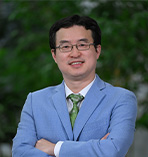
Khalifa University
Prof. TieJun (TJ) Zhang is a Professor of Mechanical Engineering at the Khalifa University and a Member of the Mohammed bin Rashed Academy of Scientists (UAE’s National Academy). He also serves as the Theme Leader of Abu Dhabi Virtual Research Institute for Sustainability (Energy). He was a Visiting Assistant Professor at the Massachusetts Institute of Technology (MIT) and a Postdoctoral Research Associate at the Rensselaer Polytechnic Institute (RPI) in USA. As one of World’s Top 2% of Scientists, he has over 160 peer-reviewed publications and multiple international patents. As an educator, he has mentored over 60 PhD & MSc students and research staffs as well as many intern students. Prof. Zhang is the recipient of the UAE National Research Foundation University-Industry Research Collaboration Award and the Abu Dhabi Award for Research Excellence. He has been the Principal Investigator of many research projects (~US$15 millions) on energy, water and micro/nanotechnologies. Prof. Zhang is an Associate Editor of ASME Journal of Micro and Nano-Manufacturing.
PV-driven green hydrogen production is instrumental for achieving sustainable development goals globally. As a synergetic effort to enhance electrocatalytic water splitting performance, structuring electrodes is equally important as increasing the intrinsic activity of catalysts for practical applications. Hierarchically porous electrodes offer abundant cavities for gas nucleation and reduced contact line for fast departure of hydrogen/oxygen bubbles in order to minimize the bubble coverage on catalyst and the associated transport overpotential. With microscopic high-speed imaging, we capture the dynamics of bubbles generated on porous electrode surface and reveal the correlations among the bubble population, bubble number density, bubble departure frequency with bubble overpotential and catalytic performance. Our characterization results elucidate the fundamental roles of electrode structure and interfacial mass transport in reducing overpotential of water splitting, including bubble ohmic overpotential, bubble overpotential and concentration overpotential. By tailoring the electrode surface structures with 2D materials, we have observed various oxygen bubble behaviors at the electrolyte-electrode interface, which result in different transport energy losses. In addition, based on the spin-polarized density functional theory, first-principles simulation is carried out to probe more insights into pure/doped catalyst-substrate interface, where the charge transfer is influenced by interfacial bonding and reconstruction.